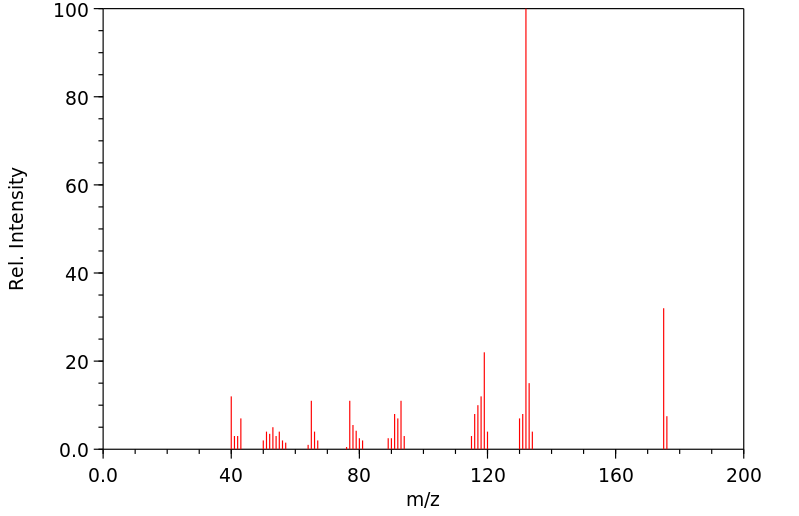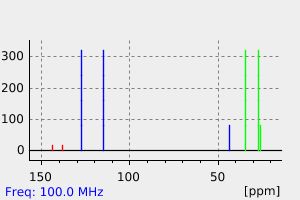4-环己苯胺 | 6373-50-8
中文名称
4-环己苯胺
中文别名
4-环己基苯胺
英文名称
p-cyclohexylaniline
英文别名
4-Cyclohexylaniline;para-cyclohexylaniline;4-cyclohexylbenzenamine;4-cyclohexylphenylamine
CAS
6373-50-8
化学式
C12H17N
mdl
MFCD00001454
分子量
175.274
InChiKey
JLNMBIKJQAKQBH-UHFFFAOYSA-N
BEILSTEIN
——
EINECS
——
-
物化性质
-
计算性质
-
ADMET
-
安全信息
-
SDS
-
制备方法与用途
-
上下游信息
-
文献信息
-
表征谱图
-
同类化合物
-
相关功能分类
-
相关结构分类
物化性质
-
熔点:53 °C
-
沸点:166 °C
-
密度:1.013
-
闪点:110°C
-
稳定性/保质期:
在常温常压下,它是一种稳定的棕色固体。
计算性质
-
辛醇/水分配系数(LogP):3.7
-
重原子数:13
-
可旋转键数:1
-
环数:2.0
-
sp3杂化的碳原子比例:0.5
-
拓扑面积:26
-
氢给体数:1
-
氢受体数:1
安全信息
-
危险等级:6.1
-
危险类别码:R20/21/22
-
危险品运输编号:2811
-
海关编码:2921420090
-
包装等级:III
-
危险类别:6.1
-
安全说明:S26,S37/39
-
危险性防范说明:P261,P280,P305+P351+P338
-
危险性描述:H302+H312,H315,H319,H335
-
储存条件:请将药品存放在避光、阴凉且干燥的地方,并密封保存。
SDS
| Name: | 4-Cyclohexylaniline 97% Material Safety Data Sheet |
| Synonym: | None |
| CAS: | 6373-50-8 |
Synonym:None
Section 2 - COMPOSITION, INFORMATION ON INGREDIENTS
| CAS# | Chemical Name | content | EINECS# |
| 6373-50-8 | 4-Cyclohexylaniline, 97% | 97% | 228-918-9 |
Risk Phrases: 20/21/22
Section 3 - HAZARDS IDENTIFICATION
EMERGENCY OVERVIEW
Harmful by inhalation, in contact with skin and if swallowed.The toxicological properties of this material have not been fully investigated.
Potential Health Effects
Eye:
Causes eye irritation.
Skin:
Causes skin irritation.
Ingestion:
Causes gastrointestinal irritation with nausea, vomiting and diarrhea. The toxicological properties of this substance have not been fully investigated. Overexposure may cause methemoglobinemia.
Inhalation:
Causes respiratory tract irritation. The toxicological properties of this substance have not been fully investigated.
Chronic:
No information found.
Section 4 - FIRST AID MEASURES
Eyes: Flush eyes with plenty of water for at least 15 minutes, occasionally lifting the upper and lower eyelids. Get medical aid.
Skin:
Flush skin with plenty of water for at least 15 minutes while removing contaminated clothing and shoes. Get medical aid if irritation develops or persists.
Ingestion:
Do not induce vomiting. If victim is conscious and alert, give 2-4 cupfuls of milk or water. Never give anything by mouth to an unconscious person. Get medical aid.
Inhalation:
Remove from exposure and move to fresh air immediately. If not breathing, give artificial respiration. If breathing is difficult, give oxygen. Get medical aid if cough or other symptoms appear.
Notes to Physician:
Section 5 - FIRE FIGHTING MEASURES
General Information:
As in any fire, wear a self-contained breathing apparatus in pressure-demand, MSHA/NIOSH (approved or equivalent), and full protective gear.
Extinguishing Media:
Use water spray, dry chemical, or carbon dioxide.
Section 6 - ACCIDENTAL RELEASE MEASURES
General Information: Use proper personal protective equipment as indicated in Section 8.
Spills/Leaks:
Vacuum or sweep up material and place into a suitable disposal container. Clean up spills immediately, observing precautions in the Protective Equipment section.
Section 7 - HANDLING and STORAGE
Handling:
Wash thoroughly after handling. Wash hands before eating. Use with adequate ventilation. Avoid breathing dust, vapor, mist, or gas.
Avoid contact with skin and eyes. Avoid ingestion and inhalation.
Storage:
Store in a cool, dry place. Store in a tightly closed container.
Section 8 - EXPOSURE CONTROLS, PERSONAL PROTECTION
Engineering Controls:
Use adequate ventilation to keep airborne concentrations low.
Exposure Limits CAS# 6373-50-8: Personal Protective Equipment Eyes: Wear appropriate protective eyeglasses or chemical safety goggles as described by OSHA's eye and face protection regulations in 29 CFR 1910.133 or European Standard EN166.
Skin:
Wear appropriate protective gloves to prevent skin exposure.
Clothing:
Wear appropriate protective clothing to prevent skin exposure.
Respirators:
Follow the OSHA respirator regulations found in 29 CFR 1910.134 or European Standard EN 149. Use a NIOSH/MSHA or European Standard EN 149 approved respirator if exposure limits are exceeded or if irritation or other symptoms are experienced.
Section 9 - PHYSICAL AND CHEMICAL PROPERTIES
Physical State: Solid
Color: brown
Odor: Not available.
pH: Not available.
Vapor Pressure: Not available.
Viscosity: Not available.
Boiling Point: 166 deg C @ 13.00mm Hg
Freezing/Melting Point: 53 - 56 deg C
Autoignition Temperature: Not available.
Flash Point: > 110 deg C (> 230.00 deg F)
Explosion Limits, lower: Not available.
Explosion Limits, upper: Not available.
Decomposition Temperature:
Solubility in water:
Specific Gravity/Density:
Molecular Formula: C12H17N
Molecular Weight: 175.27
Section 10 - STABILITY AND REACTIVITY
Chemical Stability:
Stable under normal temperatures and pressures.
Conditions to Avoid:
Incompatible materials.
Incompatibilities with Other Materials:
Strong oxidizing agents and strong acids.
Hazardous Decomposition Products:
Nitrogen oxides, carbon monoxide, carbon dioxide.
Hazardous Polymerization: Has not been reported.
Section 11 - TOXICOLOGICAL INFORMATION
RTECS#:
CAS# 6373-50-8 unlisted.
LD50/LC50:
Not available.
Carcinogenicity:
4-Cyclohexylaniline, 97% - Not listed by ACGIH, IARC, or NTP.
Section 12 - ECOLOGICAL INFORMATION
Section 13 - DISPOSAL CONSIDERATIONS
Dispose of in a manner consistent with federal, state, and local regulations.
Section 14 - TRANSPORT INFORMATION
IATA
Not regulated as a hazardous material.
IMO
Not regulated as a hazardous material.
RID/ADR
Not regulated as a hazardous material.
Section 15 - REGULATORY INFORMATION
European/International Regulations
European Labeling in Accordance with EC Directives
Hazard Symbols: XN
Risk Phrases:
R 20/21/22 Harmful by inhalation, in contact with
skin and if swallowed.
Safety Phrases:
S 24/25 Avoid contact with skin and eyes.
WGK (Water Danger/Protection)
CAS# 6373-50-8: No information available.
Canada
None of the chemicals in this product are listed on the DSL/NDSL list.
CAS# 6373-50-8 is not listed on Canada's Ingredient Disclosure List.
US FEDERAL
TSCA
CAS# 6373-50-8 is not listed on the TSCA inventory.
It is for research and development use only.
SECTION 16 - ADDITIONAL INFORMATION
N/A
上下游信息
-
上游原料
中文名称 英文名称 CAS号 化学式 分子量 环己基苯 1-phenyl-1-cyclohexane 827-52-1 C12H16 160.259 4-环己基-1-硝基苯 4-cyclohexylnitrobenzene 5458-48-0 C12H15NO2 205.257 N-(4-环己基苯基)乙酰胺 N-(4-cyclohexylphenyl)acetamide 29030-57-7 C14H19NO 217.311 1-溴-4-环己基苯 4-bromo(cyclohexyl)benzene 25109-28-8 C12H15Br 239.155 1-(4'-环己基-苯基)-1-羟基-乙烷 1-(4'-Cyclohexyl-phenyl)-1-hydroxy-ethane 29030-52-2 C14H20O 204.312 4'-环己基苯乙酮 4-cyclohexylacetophenone 18594-05-3 C14H18O 202.296 1,1-双(4-氨基苯基)环己烷 1,1-bis-(4-aminophenyl)cyclohexane 3282-99-3 C18H22N2 266.386 1-环己-3-烯基-4-硝基-苯 1-cyclohex-3-enyl-4-nitro-benzene 105908-26-7 C12H13NO2 203.241 —— ossima del 4-cicloesilacetofenone 74067-99-5 C14H19NO 217.311 -
下游产品
中文名称 英文名称 CAS号 化学式 分子量 —— 4-cyclohexyl-N-methylaniline —— C13H19N 189.301 —— 4-cyclohexyl-N,N-dimethylaniline —— C14H21N 203.327 —— 4,4’-dicyclohexyldiphenylamine 163687-39-6 C24H31N 333.517 1-环己基-4-异氰酰基苯 4-cyclohexylphenyl isocyanate 191722-72-2 C13H15NO 201.268 —— 1-Cyclohexyl-4-isothiocyanatobenzene 78290-46-7 C13H15NS 217.335 N-(4-环己基苯基)乙酰胺 N-(4-cyclohexylphenyl)acetamide 29030-57-7 C14H19NO 217.311 N-(4-环己基苯基)硫脲 1-(4-cyclohexylphenyl)thiourea 175205-17-1 C13H18N2S 234.365 N-(4-环己基苯基)-甘氨酸 N-(4-cyclohexyl-phenyl)-glycine 101114-35-6 C14H19NO2 233.31 —— N-benzyl-4-cyclohexylaniline —— C19H23N 265.398 1-溴-4-环己基苯 4-bromo(cyclohexyl)benzene 25109-28-8 C12H15Br 239.155 1-氯-4-环己基苯 1-chloro-4-cyclohexylbenzene 829-32-3 C12H15Cl 194.704 对环己基苯酚 p-cyclohexylphenol 1131-60-8 C12H16O 176.258 2-氯-N-(4-环己基苯基)乙酰胺 2-chloro-N-(4-cyclohexylphenyl)acetamide 212055-50-0 C14H18ClNO 251.756 —— p-iodocyclohexylbenzene 91639-29-1 C12H15I 286.156 —— 4-cyclohexyl-2,6-diethyl-aniline 67330-55-6 C16H25N 231.381 —— (4-cyclohexyl-phenyl)-oxiranylmethyl-amine 1058160-01-2 C15H21NO 231.338 —— cHEU 804325-28-8 C15H22N2O 246.352 —— N,N-Dimethyl-N'-(p-cyclohexylphenyl)urea 88132-41-6 C15H22N2O 246.352 —— 1-(4-cyclohexylphenyl)piperazine —— C16H24N2 244.38 —— cHCEU 74746-36-4 C15H21ClN2O 280.798 —— 4-(((4-cyclohexylphenyl)amino)methyl)phenol —— C19H23NO 281.398 —— (E)-N-(4-Cyclohexyl-phenyl)-3-ethoxy-acrylamide 1025975-45-4 C17H23NO2 273.375 —— 3-[(4-cyclohexylphenyl)hydrazono]pentane-2,4-dione 1238700-97-4 C17H22N2O2 286.374 —— 2-azido-4-cyclohexylaniline 1410063-83-0 C12H16N4 216.286 —— Methyl [(4-cyclohexylphenyl)amino](oxo)acetate 892491-75-7 C15H19NO3 261.321 —— N-(4-Cyclohexylphenyl)-2-hydrazino-2-oxoacetamide 892491-74-6 C14H19N3O2 261.324 —— 4'-cyclohexylthiobenzanilide 147701-85-7 C19H21NS 295.448 —— 4-(2-(4-cyclohexylphenylamino)ethyl)-1H-imidazole 1225013-19-3 C17H23N3 269.39 —— 2-chloro-N-[(4-cyclohexylphenyl)carbamoyl]acetamide 1063657-10-2 C15H19ClN2O2 294.781 N-(4-环己基苯基)-4,5-二氢-1H-咪唑-2-胺 2-(p-Cyclohexylphenylamino)-2-imidazoline 71576-66-4 C15H21N3 243.352 —— N-(4-Cyclohexyl-phenyl)-4-methyl-thiobenzamide 147701-86-8 C20H23NS 309.475 —— N2-(4-cyclohexylphenyl)-4,6-dichloro-1,3,5-triazin-2-amine —— C15H16Cl2N4 323.225 —— N-(4-Cyclohexyl-phenyl)-2-(piperidine)-acetamide 81112-74-5 C19H28N2O 300.444 —— 4-((4-Cyclohexylphenylamino)methyl)benzoic acid methyl ester 385837-16-1 C21H25NO2 323.435 - 1
- 2
- 3
- 4
反应信息
-
作为反应物:参考文献:名称:Mayes; Turner, Journal of the Chemical Society, 1929, p. 507摘要:DOI:
-
作为产物:参考文献:名称:Neunhoeffer, Journal fur praktische Chemie (Leipzig 1954), 1932, vol. <2> 133, p. 95,105摘要:DOI:
文献信息
-
Compositions for Treatment of Cystic Fibrosis and Other Chronic Diseases申请人:Vertex Pharmaceuticals Incorporated公开号:US20150231142A1公开(公告)日:2015-08-20The present invention relates to pharmaceutical compositions comprising an inhibitor of epithelial sodium channel activity in combination with at least one ABC Transporter modulator compound of Formula A, Formula B, Formula C, or Formula D. The invention also relates to pharmaceutical formulations thereof, and to methods of using such compositions in the treatment of CFTR mediated diseases, particularly cystic fibrosis using the pharmaceutical combination compositions.
-
Inhibitors of histone deacetylase申请人:——公开号:US20020177594A1公开(公告)日:2002-11-28Compounds having the formula 1 or therapeutically acceptable salts thereof, are histone deacetylase (HDAC) inhibitors. Preparation of the compounds, compositions containing the compounds, and treatment of diseases using the compounds are disclosed.
-
[EN] NOVEL SMALL MOLECULE INHIBITORS OF TEAD TRANSCRIPTION FACTORS<br/>[FR] NOUVEAUX INHIBITEURS À PETITES MOLÉCULES DE FACTEURS DE TRANSCRIPTION TEAD申请人:MASSACHUSETTS GEN HOSPITAL公开号:WO2020190774A1公开(公告)日:2020-09-24The present disclosure compounds, as well as their compositions and methods of use. The compounds inhibit the activity of the TEAD transcription factor, and are useful in the treatment of diseases related to the activity of TEAD transcription factor including, e.g., cancer and other diseases.
-
[EN] GLYCOLATE OXIDASE INHIBITORS FOR THE TREATMENT OF DISEASE<br/>[FR] INHIBITEURS DE GLYCOLATE OXYDASE POUR LE TRAITEMENT D'UNE MALADIE申请人:BIOMARIN PHARM INC公开号:WO2020257487A1公开(公告)日:2020-12-24Described herein are compounds, methods of making such compounds, pharmaceutical compositions and medicaments containing such compounds, and methods of using such compounds to treat or prevent diseases or disorders associated with a defect in glyoxylate metabolism, for example a disease or disorder associated with the enzyme glycolate oxidase (GO) or alterations in oxalate metabolism. Such diseases or disorders include, for example, disorders of glyoxylate metabolism, including primary hyperoxaluria, that are associated with production of excessive amounts of oxalate.
-
Direct Tryptophols Synthesis from 2-Vinylanilines and Alkynes via C≡C Triple Bond Cleavage and Dioxygen Activation作者:Tao Shen、Yiqun Zhang、Yu-Feng Liang、Ning JiaoDOI:10.1021/jacs.6b08094日期:2016.10.12metal-free C≡C triple bond cleavage, dioxygen activation, and reassembly into tryptophol derivatives has been developed. This chemistry provides a novel, simple, and efficient approach to highly valuable tryptophol derivatives from simple substrates under mild conditions. The mechanistic studies may promote the discovery of new methodologies through C-C bond cleavage and dioxygen activation.
表征谱图
-
氢谱1HNMR
-
质谱MS
-
碳谱13CNMR
-
红外IR
-
拉曼Raman
-
峰位数据
-
峰位匹配
-
表征信息
同类化合物
(βS)-β-氨基-4-(4-羟基苯氧基)-3,5-二碘苯甲丙醇
(S,S)-邻甲苯基-DIPAMP
(S)-(-)-7'-〔4(S)-(苄基)恶唑-2-基]-7-二(3,5-二-叔丁基苯基)膦基-2,2',3,3'-四氢-1,1-螺二氢茚
(S)-盐酸沙丁胺醇
(S)-3-(叔丁基)-4-(2,6-二甲氧基苯基)-2,3-二氢苯并[d][1,3]氧磷杂环戊二烯
(S)-2,2'-双[双(3,5-三氟甲基苯基)膦基]-4,4',6,6'-四甲氧基联苯
(S)-1-[3,5-双(三氟甲基)苯基]-3-[1-(二甲基氨基)-3-甲基丁烷-2-基]硫脲
(R)富马酸托特罗定
(R)-(-)-盐酸尼古地平
(R)-(-)-4,12-双(二苯基膦基)[2.2]对环芳烷(1,5环辛二烯)铑(I)四氟硼酸盐
(R)-(+)-7-双(3,5-二叔丁基苯基)膦基7''-[((6-甲基吡啶-2-基甲基)氨基]-2,2'',3,3''-四氢-1,1''-螺双茚满
(R)-(+)-7-双(3,5-二叔丁基苯基)膦基7''-[(4-叔丁基吡啶-2-基甲基)氨基]-2,2'',3,3''-四氢-1,1''-螺双茚满
(R)-(+)-7-双(3,5-二叔丁基苯基)膦基7''-[(3-甲基吡啶-2-基甲基)氨基]-2,2'',3,3''-四氢-1,1''-螺双茚满
(R)-(+)-4,7-双(3,5-二-叔丁基苯基)膦基-7“-[(吡啶-2-基甲基)氨基]-2,2”,3,3'-四氢1,1'-螺二茚满
(R)-3-(叔丁基)-4-(2,6-二苯氧基苯基)-2,3-二氢苯并[d][1,3]氧杂磷杂环戊烯
(R)-2-[((二苯基膦基)甲基]吡咯烷
(R)-1-[3,5-双(三氟甲基)苯基]-3-[1-(二甲基氨基)-3-甲基丁烷-2-基]硫脲
(N-(4-甲氧基苯基)-N-甲基-3-(1-哌啶基)丙-2-烯酰胺)
(5-溴-2-羟基苯基)-4-氯苯甲酮
(5-溴-2-氯苯基)(4-羟基苯基)甲酮
(5-氧代-3-苯基-2,5-二氢-1,2,3,4-oxatriazol-3-鎓)
(4S,5R)-4-甲基-5-苯基-1,2,3-氧代噻唑烷-2,2-二氧化物-3-羧酸叔丁酯
(4S,4''S)-2,2''-亚环戊基双[4,5-二氢-4-(苯甲基)恶唑]
(4-溴苯基)-[2-氟-4-[6-[甲基(丙-2-烯基)氨基]己氧基]苯基]甲酮
(4-丁氧基苯甲基)三苯基溴化磷
(3aR,8aR)-(-)-4,4,8,8-四(3,5-二甲基苯基)四氢-2,2-二甲基-6-苯基-1,3-二氧戊环[4,5-e]二恶唑磷
(3aR,6aS)-5-氧代六氢环戊基[c]吡咯-2(1H)-羧酸酯
(2Z)-3-[[(4-氯苯基)氨基]-2-氰基丙烯酸乙酯
(2S,3S,5S)-5-(叔丁氧基甲酰氨基)-2-(N-5-噻唑基-甲氧羰基)氨基-1,6-二苯基-3-羟基己烷
(2S,2''S,3S,3''S)-3,3''-二叔丁基-4,4''-双(2,6-二甲氧基苯基)-2,2'',3,3''-四氢-2,2''-联苯并[d][1,3]氧杂磷杂戊环
(2S)-(-)-2-{[[[[3,5-双(氟代甲基)苯基]氨基]硫代甲基]氨基}-N-(二苯基甲基)-N,3,3-三甲基丁酰胺
(2S)-2-[[[[[((1S,2S)-2-氨基环己基]氨基]硫代甲基]氨基]-N-(二苯甲基)-N,3,3-三甲基丁酰胺
(2S)-2-[[[[[[((1R,2R)-2-氨基环己基]氨基]硫代甲基]氨基]-N-(二苯甲基)-N,3,3-三甲基丁酰胺
(2-硝基苯基)磷酸三酰胺
(2,6-二氯苯基)乙酰氯
(2,3-二甲氧基-5-甲基苯基)硼酸
(1S,2S,3S,5S)-5-叠氮基-3-(苯基甲氧基)-2-[(苯基甲氧基)甲基]环戊醇
(1S,2S,3R,5R)-2-(苄氧基)甲基-6-氧杂双环[3.1.0]己-3-醇
(1-(4-氟苯基)环丙基)甲胺盐酸盐
(1-(3-溴苯基)环丁基)甲胺盐酸盐
(1-(2-氯苯基)环丁基)甲胺盐酸盐
(1-(2-氟苯基)环丙基)甲胺盐酸盐
(1-(2,6-二氟苯基)环丙基)甲胺盐酸盐
(-)-去甲基西布曲明
龙蒿油
龙胆酸钠
龙胆酸叔丁酯
龙胆酸
龙胆紫-d6
龙胆紫








